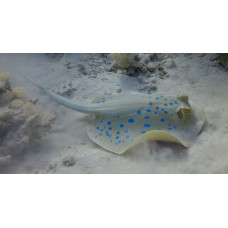Latin name
Taeniura lymma
Other name
Ribbontail stingray
Identification
The pectoral fins of these rays are fused to the head, forming an oval disk 4/5 of the length and width. The anterior margin is broadly rounded, and the snout is blunt. Behind the large eyes, prominent above the disc, there are broad spiracles. On the ventral surface of the disc are 5 pairs of gill slits, mouth and nostrils. Between the nostrils is a narrow flap of skin with a slightly fringed lower edge that reaches the mouth. There are deep furrows at the corners of the lower jaw, which has a depression in the middle. There are 15 to 24 rows of teeth on each jaw. The teeth are staggered and form a flat surface. There are two large projections on the floor of the mouth. The strongly flattened tail is 1.5 times longer than the disc. On the dorsal surface of the caudal peduncle, one or two serrated spines, connected by ducts to the venom gland, are quite far from the base. Behind the spines is a ventral fold of skin that extends to the tip of the tail, and a low dorsal ridge that runs along the spine. In general, the skin of these rays is smooth. Some individuals have several barbs in the center of the disk.
Features of fish fins
The pelvic fins are narrow and pointed. Bluespotted ribbontail rays swim with the help of their pectoral fins, which form the main part of the oval disc. The muscles located throughout the fins are always active, except when the rays are moving very slowly.
Fish colouring
Coloration of the dorsal surface of the disc bright, numerous rounded spots of neon blue color scattered on a yellowish or greenish background, increasing in density toward the edges of the disc and decreasing in size. There are two stripes of the same color along the tail. The eyes are bright yellow. The ventral surface of the belly is white. Individuals inhabiting the waters of South Africa sometimes lack the stripes on the tail. Newborn rays have a pale gray or pale brown disk with black or brownish red spots. Each litter has its own distinctive pattern.
Distribution
Widespread in tropical coastal waters of the Indo-Pacific. In the Indian Ocean, they are found from South Africa to the Arabian Peninsula and Southeast Asia, including the waters around Madagascar, Mauritius, Zanzibar, Sri Lanka, the Seychelles, and the Maldives. They are rarely caught in the Persian Gulf and the Gulf of Oman. In the Pacific Ocean, they are found from the Philippines to the north coast of Australia, in the waters of Polynesia and Melanesia, and off the Solomon Islands. Large numbers of Taeniura lymma reach the shores of South Africa each year.
Habitat
These rays stick close to coral reefs and adjacent sandbanks from the surf zone down to 30 meters, entering tide pools and algae thickets.
Size
The maximum recorded disk width is 35 cm, body length is 70 cm, and weight is 5. According to another source, the maximum recorded length is 80 cm.
Behavior
During the day, Bluespotted Ribbontail Rays usually lie motionless on the bottom in caves, under coral reefs, and other shelters (they can be found on shipwrecks), sometimes with only the tail protruding from the sediment. At night, with the tide, these stingrays hunt in small groups in shallow waters. They rarely bury themselves completely in the sand.
Food and feeding habits
They dig holes in the bottom in search of mollusks, polychaete worms, shrimp, crabs, and small bottom-dwelling fish. Once they find prey, stingrays block it with their disk and send it into their jaws, moving the disk over the victim. They are often followed by other fish that pick up what they have missed. Stingrays search for prey and may use electro-reception to recognize conspecifics.
Reproduction
The breeding season lasts from late spring to summer. Males pursue females by bringing their sensitive snout close to their cloaca, picking up chemical signals emitted by them, grabbing them by the edges of the disc, and finally biting them, after which mating takes place. The bluespotted ribbontail ray is classified as an oviparous fish. Embryos develop in the womb and feed on egg yolk and histotrophs. Pregnancy lasts from 4 to 12 months. There are up to 7 newborns in a litter with a disk 13-14 cm wide, which are exact copies of the adult except for coloration. Newborns have a soft tail that is enclosed in a leathery capsule to prevent injury to the female during birth. It is then released and can be used as a defensive weapon. Males reach sexual maturity at a disc width of 20-21 cm.
Fishing
Bluespotted skates are not targeted. They are caught as bycatch in commercial fisheries using longlines, gill nets and cages.
Relationship with a person
These rays are quite shy and non-aggressive. They have a venomous sting and live in shallow water, making them a potential danger to humans. Their bright coloration and small size make them popular with aquarists, although they do not tolerate captivity well. The flesh of these fish is used as food in Southeast Asia, East Africa, and Australia.
| Classification | |
| Phylum | Chordata |
| Class | Chondrichthyes |
| Squad | Myliobatiformes |
| Family | Dasyatidae |
| Genus | Taeniura |
| Species | T. lymma |
| Features | |
| Conservation status | Least Concern |
| Habitat | Bottom |
| Life span, years | No information |
| Maximum body weight, kg | 5 |
| Maximum length, cm | 80 |
| Sailing speed, m/s | No information |
| Threat to people | Edible |
| Way of eating | Predator |



